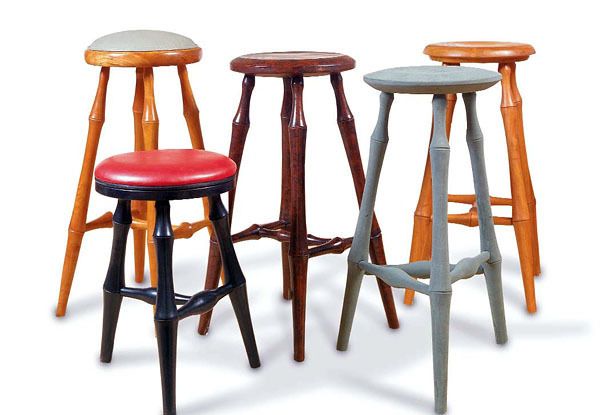Building a Basic Stool
A Windsor stool is an ideal first chairmaking project.

Synopsis: Harriet Hodges says a Windsor stool is both a good beginner project and a quick exercise for more expert woodworkers. Tool and wood needs are simple, and the process of building allows for mistakes. She advises that you begin by selecting a design, and she explains how to dimension your stock. You turn the seat and legs on a lathe, and then bore and ream the holes in the seat by hand. Next comes fitting stretchers to the legs, and then assemble of the stool and leveling the legs. Her tips along the way include how to color code your parts so assembly is quicker.
A Windsor stool makes an ideal first project for beginners or a quick exercise for woodworkers who have been at it for a while. A stool comes in handy in most households, and it can make a welcome gift. Tool and wood needs are simple. Hardwood for the undercarriage must be clear and straight-grained, but you can use wood of dubious quality for the seat. The process of building a stool allows for mistakes: I once made a tenon 1⁄2 in. too long on one leg of a stool, and it still went together just fine.
Decide on a design
To get started with a stool project, you need to decide the number of legs, style of turning, how tall, seat shape and whether to upholster. You can choose the finish later.
Three legs or four? Even if you live in a house with a pitted earth floor, a stool with three legs will never teeter. Do decide the height now. Legs can be cut down later, but tapers look clumsy when they are sawed off too close to the end, and stretchers look silly too close to the ground.
Turned bamboo patterns are handsome and easy to make. I would advise against plain legs—they bespeak factory work. Add some coves and tapers or some beaded balls. Why not make your stool interesting or even playful? Make some cardboard templates, paint them black and live with them a little. Leg diameters in the drawing on the facing page are minimums for strength.
A bead or two on the perimeter of a seat makes a nice touch. If you dish the seat, don’t overdo it. The dish doesn’t add much to comfort. With a leather top—a luxurious touch—a groove accepts the leather and a rattan spline. Or, if you’re using a soft wood, brass tacks secure the leather to the seat and add a decorative touch.
A seat diameter of 10 in. to 11 in. is approximate. Larger or smaller works. Allow enough space above the stretchers for two big feet. (I didn’t do that on my delicate first stool and quickly renamed it a child’s stool.) I like to limit the splay of the legs, but the more stability you want, the more splay you must have.
From Fine Woodworking #125
For the full article, download the PDF below:
Fine Woodworking Recommended Products

Sketchup Class

Circle Guide

Drafting Tools







Log in or create an account to post a comment.
Sign up Log in